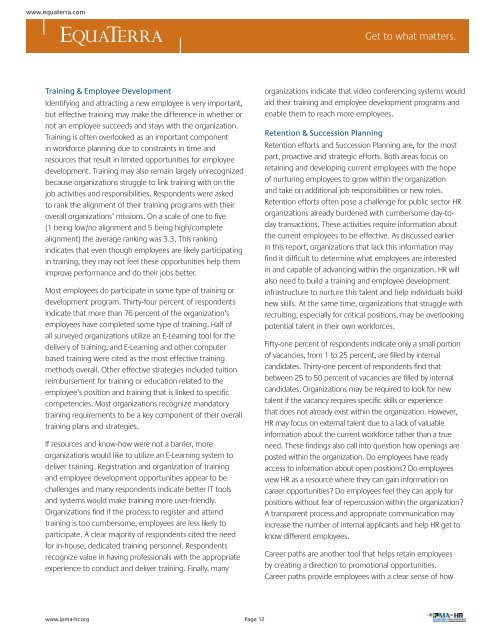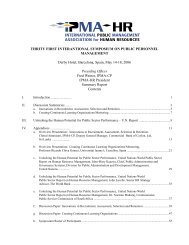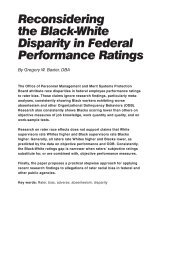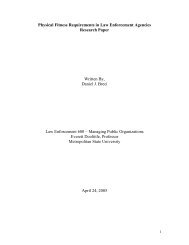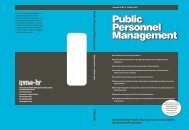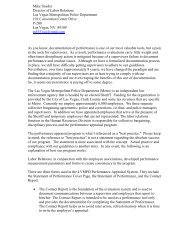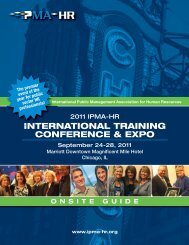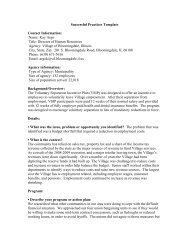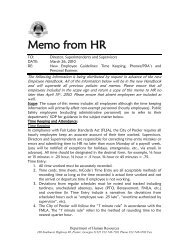The Impact of the Aging Workforce on Public Sector Organizations ...
The Impact of the Aging Workforce on Public Sector Organizations ...
The Impact of the Aging Workforce on Public Sector Organizations ...
Create successful ePaper yourself
Turn your PDF publications into a flip-book with our unique Google optimized e-Paper software.
www.equaterra.comGet to what matters.Training & Employee DevelopmentIdentifying and attracting a new employee is very important,but effective training may make <str<strong>on</strong>g>the</str<strong>on</strong>g> difference in whe<str<strong>on</strong>g>the</str<strong>on</strong>g>r ornot an employee succeeds and stays with <str<strong>on</strong>g>the</str<strong>on</strong>g> organizati<strong>on</strong>.Training is <str<strong>on</strong>g>of</str<strong>on</strong>g>ten overlooked as an important comp<strong>on</strong>entin workforce planning due to c<strong>on</strong>straints in time andresources that result in limited opportunities for employeedevelopment. Training may also remain largely unrecognizedbecause organizati<strong>on</strong>s struggle to link training with <strong>on</strong> <str<strong>on</strong>g>the</str<strong>on</strong>g>job activities and resp<strong>on</strong>sibilities. Resp<strong>on</strong>dents were askedto rank <str<strong>on</strong>g>the</str<strong>on</strong>g> alignment <str<strong>on</strong>g>of</str<strong>on</strong>g> <str<strong>on</strong>g>the</str<strong>on</strong>g>ir training programs with <str<strong>on</strong>g>the</str<strong>on</strong>g>iroverall organizati<strong>on</strong>s’ missi<strong>on</strong>s. On a scale <str<strong>on</strong>g>of</str<strong>on</strong>g> <strong>on</strong>e to fi ve(1 being low/no alignment and 5 being high/completealignment) <str<strong>on</strong>g>the</str<strong>on</strong>g> average ranking was 3.3. This rankingindicates that even though employees are likely participatingin training, <str<strong>on</strong>g>the</str<strong>on</strong>g>y may not feel <str<strong>on</strong>g>the</str<strong>on</strong>g>se opportunities help <str<strong>on</strong>g>the</str<strong>on</strong>g>mimprove performance and do <str<strong>on</strong>g>the</str<strong>on</strong>g>ir jobs better.Most employees do participate in some type <str<strong>on</strong>g>of</str<strong>on</strong>g> training ordevelopment program. Thirty-four percent <str<strong>on</strong>g>of</str<strong>on</strong>g> resp<strong>on</strong>dentsindicate that more than 76 percent <str<strong>on</strong>g>of</str<strong>on</strong>g> <str<strong>on</strong>g>the</str<strong>on</strong>g> organizati<strong>on</strong>’semployees have completed some type <str<strong>on</strong>g>of</str<strong>on</strong>g> training. Half <str<strong>on</strong>g>of</str<strong>on</strong>g>all surveyed organizati<strong>on</strong>s utilize an E-Learning tool for <str<strong>on</strong>g>the</str<strong>on</strong>g>delivery <str<strong>on</strong>g>of</str<strong>on</strong>g> training, and E-Learning and o<str<strong>on</strong>g>the</str<strong>on</strong>g>r computerbased training were cited as <str<strong>on</strong>g>the</str<strong>on</strong>g> most effective trainingmethods overall. O<str<strong>on</strong>g>the</str<strong>on</strong>g>r effective strategies included tuiti<strong>on</strong>reimbursement for training or educati<strong>on</strong> related to <str<strong>on</strong>g>the</str<strong>on</strong>g>employee’s positi<strong>on</strong> and training that is linked to specifi ccompetencies. Most organizati<strong>on</strong>s recognize mandatorytraining requirements to be a key comp<strong>on</strong>ent <str<strong>on</strong>g>of</str<strong>on</strong>g> <str<strong>on</strong>g>the</str<strong>on</strong>g>ir overalltraining plans and strategies.If resources and know-how were not a barrier, moreorganizati<strong>on</strong>s would like to utilize an E-Learning system todeliver training. Registrati<strong>on</strong> and organizati<strong>on</strong> <str<strong>on</strong>g>of</str<strong>on</strong>g> trainingand employee development opportunities appear to bechallenges and many resp<strong>on</strong>dents indicate better IT toolsand systems would make training more user-friendly.Organizati<strong>on</strong>s fi nd if <str<strong>on</strong>g>the</str<strong>on</strong>g> process to register and attendtraining is too cumbersome, employees are less likely toparticipate. A clear majority <str<strong>on</strong>g>of</str<strong>on</strong>g> resp<strong>on</strong>dents cited <str<strong>on</strong>g>the</str<strong>on</strong>g> needfor in-house, dedicated training pers<strong>on</strong>nel. Resp<strong>on</strong>dentsrecognize value in having pr<str<strong>on</strong>g>of</str<strong>on</strong>g>essi<strong>on</strong>als with <str<strong>on</strong>g>the</str<strong>on</strong>g> appropriateexperience to c<strong>on</strong>duct and deliver training. Finally, manyorganizati<strong>on</strong>s indicate that video c<strong>on</strong>ferencing systems wouldaid <str<strong>on</strong>g>the</str<strong>on</strong>g>ir training and employee development programs andenable <str<strong>on</strong>g>the</str<strong>on</strong>g>m to reach more employees.Retenti<strong>on</strong> & Successi<strong>on</strong> PlanningRetenti<strong>on</strong> efforts and Successi<strong>on</strong> Planning are, for <str<strong>on</strong>g>the</str<strong>on</strong>g> mostpart, proactive and strategic efforts. Both areas focus <strong>on</strong>retaining and developing current employees with <str<strong>on</strong>g>the</str<strong>on</strong>g> hope<str<strong>on</strong>g>of</str<strong>on</strong>g> nurturing employees to grow within <str<strong>on</strong>g>the</str<strong>on</strong>g> organizati<strong>on</strong>and take <strong>on</strong> additi<strong>on</strong>al job resp<strong>on</strong>sibilities or new roles.Retenti<strong>on</strong> efforts <str<strong>on</strong>g>of</str<strong>on</strong>g>ten pose a challenge for public sector HRorganizati<strong>on</strong>s already burdened with cumbersome day-todaytransacti<strong>on</strong>s. <str<strong>on</strong>g>The</str<strong>on</strong>g>se activities require informati<strong>on</strong> about<str<strong>on</strong>g>the</str<strong>on</strong>g> current employees to be effective. As discussed earlierin this report, organizati<strong>on</strong>s that lack this informati<strong>on</strong> mayfi nd it diffi cult to determine what employees are interestedin and capable <str<strong>on</strong>g>of</str<strong>on</strong>g> advancing within <str<strong>on</strong>g>the</str<strong>on</strong>g> organizati<strong>on</strong>. HR willalso need to build a training and employee developmentinfrastructure to nurture this talent and help individuals buildnew skills. At <str<strong>on</strong>g>the</str<strong>on</strong>g> same time, organizati<strong>on</strong>s that struggle withrecruiting, especially for critical positi<strong>on</strong>s, may be overlookingpotential talent in <str<strong>on</strong>g>the</str<strong>on</strong>g>ir own workforces.Fifty-<strong>on</strong>e percent <str<strong>on</strong>g>of</str<strong>on</strong>g> resp<strong>on</strong>dents indicate <strong>on</strong>ly a small porti<strong>on</strong><str<strong>on</strong>g>of</str<strong>on</strong>g> vacancies, from 1 to 25 percent, are fi lled by internalcandidates. Thirty-<strong>on</strong>e percent <str<strong>on</strong>g>of</str<strong>on</strong>g> resp<strong>on</strong>dents fi nd thatbetween 25 to 50 percent <str<strong>on</strong>g>of</str<strong>on</strong>g> vacancies are fi lled by internalcandidates. Organizati<strong>on</strong>s may be required to look for newtalent if <str<strong>on</strong>g>the</str<strong>on</strong>g> vacancy requires specifi c skills or experiencethat does not already exist within <str<strong>on</strong>g>the</str<strong>on</strong>g> organizati<strong>on</strong>. However,HR may focus <strong>on</strong> external talent due to a lack <str<strong>on</strong>g>of</str<strong>on</strong>g> valuableinformati<strong>on</strong> about <str<strong>on</strong>g>the</str<strong>on</strong>g> current workforce ra<str<strong>on</strong>g>the</str<strong>on</strong>g>r than a trueneed. <str<strong>on</strong>g>The</str<strong>on</strong>g>se fi ndings also call into questi<strong>on</strong> how openings areposted within <str<strong>on</strong>g>the</str<strong>on</strong>g> organizati<strong>on</strong>. Do employees have readyaccess to informati<strong>on</strong> about open positi<strong>on</strong>s? Do employeesview HR as a resource where <str<strong>on</strong>g>the</str<strong>on</strong>g>y can gain informati<strong>on</strong> <strong>on</strong>career opportunities? Do employees feel <str<strong>on</strong>g>the</str<strong>on</strong>g>y can apply forpositi<strong>on</strong>s without fear <str<strong>on</strong>g>of</str<strong>on</strong>g> repercussi<strong>on</strong> within <str<strong>on</strong>g>the</str<strong>on</strong>g> organizati<strong>on</strong>?A transparent process and appropriate communicati<strong>on</strong> mayincrease <str<strong>on</strong>g>the</str<strong>on</strong>g> number <str<strong>on</strong>g>of</str<strong>on</strong>g> internal applicants and help HR get toknow different employees.Career paths are ano<str<strong>on</strong>g>the</str<strong>on</strong>g>r tool that helps retain employeesby creating a directi<strong>on</strong> to promoti<strong>on</strong>al opportunities.Career paths provide employees with a clear sense <str<strong>on</strong>g>of</str<strong>on</strong>g> howwww.ipma-hr.orgPage 12


